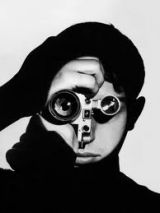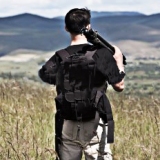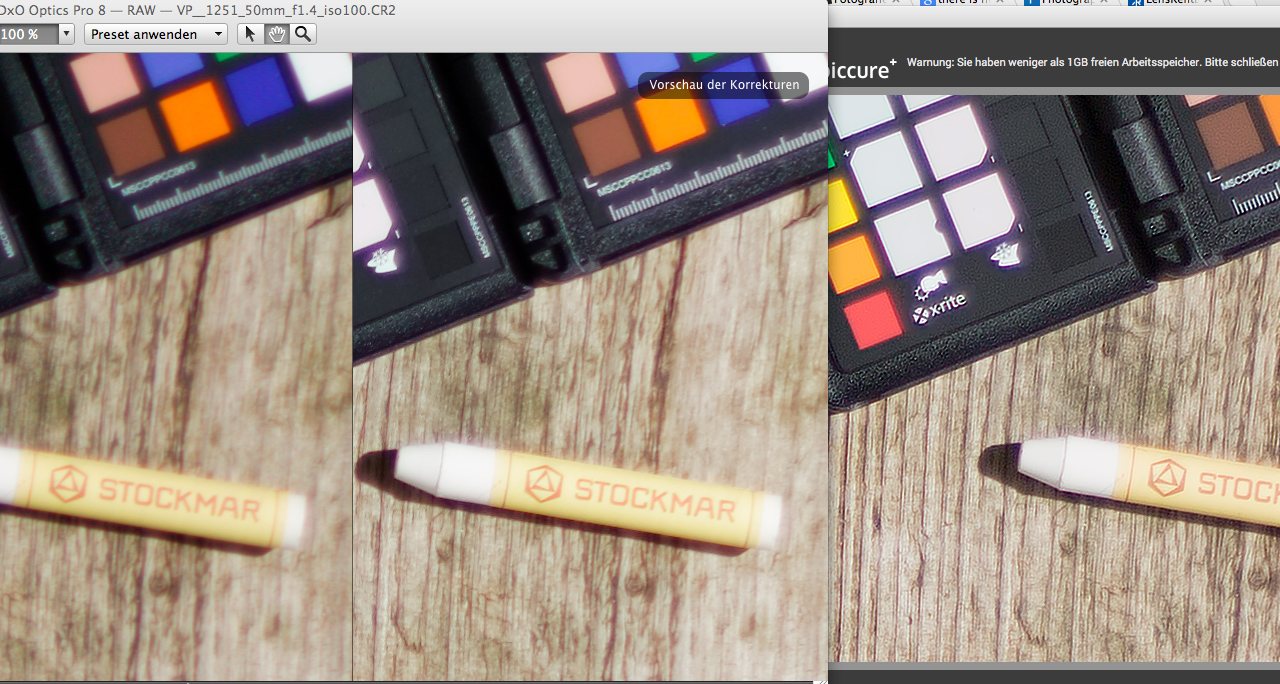- Forum
- General Discussion | Introductions | Off Topic Forum
- Photography General Discussion
- Does anyone use Piccure+
Does anyone use Piccure+
-

- Prago
- Master of the Lens
-
- Nikon D300
- Followers: 231
- Posts: 1665
-
Points:
13315
-

- Lui
- Newbie
- Followers: 0
-
Points:
0
Post #410389
the programs are very different:
How optical aberrations are determined:
- LR, DxO etc. use lens profiles which are based on a test shot with a specific lens and a finite set of settings
- The tool from title of this thread determines the optical aberrations for your equipment based on the image at hand and mathematically describes them as point-spread-functions (LR, DxO and others don't do it like that).
This means, that only one of the solutions mentioned is capable of taking into account lens-to-lens deviations. If you ever wondered why a lens got a lot if good critique and bad critique at the same time: it's because of the deviations between the lenses. There are a few articles about that topic in the web e.g. "There is no perfect lens". This means: lens profiles apply corrections to an image that may suffer from actually different aberrations due to lens-to-lens variation (the difference between the lens that was used to measure the profile and YOUR lens).
How optical aberrations are reversed:
- Lens softness can't be corrected automatically in LR, DxO uses some form of unsharp masking based on test shots
- The tool from title of this thread reverses the optical aberrations by the means of deconvolution (which is similar to what Hubble did)
There are test-shots available on the website of the program mentioned to compare the results yourself. The program does not replace the functionality of DxO/LR etc. - but complements those tools. For strong optical aberrations (e.g. open aperture) lens profile and "unsharp masking" based solutions sometimes leave room for improvement.
So the tools mentioned do different thing and have different strengths. In other forums they posted before/after shots between the solutions. Just google.
So it's not true that it does what others already do. It can account for the optical flaws of your equipment specifically, describe them in a mathematically very sophisticated way and reverse them with "space technology".
All the info can also be found on the web (e.g. websites of the respective companies).
Best,
Lui
Post #410391
Also to any interested parties here DxO's Optic Pro 8 is available free this is good till the end of January of 15. They are releasing version 10 so they are making 8 a total freebie in hopes that we like it enough to upgrade to 10.
www.dxo.com/intl/dphotographer
-

- Lui
- Newbie
- Followers: 0
-
Points:
0
Post #410392
it is not about "AF lenses" or "manual lenses" or "how accurate is the AF system". The program is not for the "anal pixel peeping crowd".
- You can have two identical lenses (same manufacturer, same model) with 100% same settings and 0% deviations of AF system. The actual optical performance may differ more than 4%... It could be more like 10-15% in terms of sharpness (MTF50). So maybe you are lucky and the lens profile has the same optical aberrations as your own equipment. In addition to that: there is only a finite number if settings for which a lens profile has been measured...
- At fast apertures lenses may not be as good as they seem. You can see a lot of "smearing" at open aperture towards the edges and lens sharpness drops as much as 70+% towards the edges. Correcting those things with something like "unsharp masking" or "smartsharpen" is not that easy - if not impossible.
However, if the image "appears very sharp and crisp" - the program mentioned in the thread will obviously be of less help. So when shooting f5.6 with a Zeiss Otus you will not need it. But with the Canon/Nikon 50mm/1.4 things look different for fast apertures.
Take an image with strong optical aberration (e.g. open aperture) and check how the different solutions compare. It is not about "how accurate the AF measurement/data is" but "how strong the optical aberrations are and how big the modeled over the true error is in lens profiles".
If you use LR/DxO and you are super happy shooting at f5.6 - I agree. But at 1.4, 2.8 and 3.5 -> lens softness mostly remains in images for those solutions... Again: depends on the lens. Super sharp lenses without lens softness do not fall into that category obviously.
Best,
Lui
Post #410394
-

- Lui
- Newbie
- Followers: 0
-
Points:
0
Post #410397
I disagree.
I would agree insofar as that "lens profile based solutions could never take equipment individual deviations into account".
An example (image can be downloaded freely from the website of program mentioned):
- Far left (Original - Canon 50mm/1.4)
- Middle (DxO 8 - you can see I already found the link to the free version of DxO 8; all optical corrections applied)
- Right (program mentioned)
The image section shown is about half way between the center and the upper right edge.
"AF lens variation" has little to do with the general problem. I agree: micro adjusting the AF system can improve image sharpness, but again, optical aberrations such as chromatic aberrations, astigmatism and "loss in sharpness towards the edges" have little to do with the AF system. The image above was taken by a company evaluating lenses and the AF was manually adjusted. The "lack of sharpness towards the edges" has nothing to do with AF - it is a problem of the optical system.
As for the pixel peepers: if you spend 1500 USD on a lens you'd certainly want it to be sharp. There are many (valid) discussions in the web and also reviews about those 1500 USD lenses which are just "not delivering 1500 USD sharpness". An example below:
www.dpreview.com/lensreviews/nikon-58mm-f1-4g/3
The MTF50 (sharpness) of that premium prime lens is equally "good" at open aperture like a kit lens... A MTF50 of 1000 in the center and 500 at the edges for the Nikon is pretty pretty pretty bad.
But I believe in the freedom of choice: those who care about the sharpness in their images can use the programs mentioned and get expensive equipment, those that don't - simply don't.
However, some technical statements made here were just incorrect.
Best,
Lui
-

- Carlos
- Photography Hooked
-
- (2) Canon 7D's
- Followers: 83
- Posts: 517
-
Points:
2591
-

- Luca
- The Lounger
-
- Nikon D7000
- Followers: 174
- Posts: 1020
-
Points:
7303
-

- Tim Kelley
- Snapobsessed
-
- Nikon D700
- Followers: 98
- Posts: 484
-
Points:
4382
-

- garyrhook
- Oh Wise One
-
- Nikon D850, Nikon D750, Panasonic G7K
- Followers: 912
- Posts: 11103
-
Points:
67681
Post #410517
A 14-day free trial is offered. One is tempted to check it out and compare to other tools.
In the meantime, it appears to be an expensive one-trick-pony, and/or a solution in search of a problem.
-

- Lui
- Newbie
- Followers: 0
-
Points:
0
Post #410520
Decision wise: if you just spend $3000 on a camera and a lens - it may actually not be entirely stupid to use software like that if it can actually correct optical aberrations that can otherwise not be corrected for 1/30th of your equipment's price-tag... And I do not want to argue with "whether that makes sense or not" - it's a personal decision. But except for the Zeiss Otus and the Sigma - there are very few to no lenses which are actually "quite usable in terms of sharpness" at open/fast apertures. Just check DPReview. So why would anybody buy a 1500 USD lens in the first place?
And btw: it fully integrates into LR, PS CC and PSE.
Best,
Lui
PS: Well, it may actually be of equal use for kit-lens users as for users of expensive lenses... So maybe I was wrong about my assumption that only "professional photographers" would use such a tool.
-

- Robert Chen
- Photography Hooked
-
- Nikon D300
- Followers: 194
- Posts: 794
-
Points:
5860
Post #410522
garyrhook wrote: Detailed analysis (above) aside, there's far more to processing an image than nitpicking lens distortion. And given the softness that passes for acceptable for many, it's difficult to understand how this can possibly be of any value.
A 14-day free trial is offered. One is tempted to check it out and compare to other tools.
In the meantime, it appears to be an expensive one-trick-pony, and/or a solution in search of a problem.
Next please
Nikon D300 24-70mm f2.8
70-200mm f2.8
50mm f1.4 & 50mm f1.8
105mm f2.8
2 SB800
-

- Chris Briggs
- Photography Hooked
-
- Nikon D800
- Followers: 157
- Posts: 739
-
Points:
9335
Post #410532
Another clip showing how this can be fixed in Photoshop for videos
-

- Chris Briggs
- Photography Hooked
-
- Nikon D800
- Followers: 157
- Posts: 739
-
Points:
9335
-

- Chris Briggs
- Photography Hooked
-
- Nikon D800
- Followers: 157
- Posts: 739
-
Points:
9335
Post #410534
- Forum
- General Discussion | Introductions | Off Topic Forum
- Photography General Discussion
- Does anyone use Piccure+
Latest Reviews
The Canon EOS R100 is an entry-level mirrorless camera introduced in 2023. But just because it’s an entry-level camera doesn’t mean it’s a bare-bones camera. Find out why in this review!
Nikon’s retro-looking Nikon Zfc is anything but retro. Under its classic body is a host of features and amenities that make it a worthwhile compact mirrorless camera for 2024.
The Canon EOS R50 is one of the newest R-system cameras from Canon. Is it worth your money? Find out all the details you need to know in this comprehensive review.
The Sony FE 70-200mm f/2.8 GM OSS II is Sony’s flagship mirrorless zoom lens. As such, it’s loaded with features and has a top-shelf build quality that makes it a top pick!
Forum Top Posters
-
1TCav 5 posts
-
2Randy Shaw 4 posts
-
3Prago 4 posts
-
4Foggy 4 posts
-
5Razky 4 posts
-
6CharleyL 3 posts
-
7db3348 3 posts
-
8CaptNemo 3 posts
-
9Sandy Smith Photos 3 posts
-
10Steve Zahra 2 posts
Latest Articles
The Canon EOS R100 is an entry-level mirrorless camera introduced in 2023. But just because it’s an entry-level camera doesn’t mean it’s a bare-bones camera. Find out why in this review!
Are you ready to upgrade your camera? Before buying new, you might consider the value of purchasing used gear to save money.
The Olympus OM-D E-M10 Mark IV is a micro four thirds camera released in 2020. It’s an entry-level system along with the OM-D E-M5 Mark III. Use this guide to determine which one is best for you!
Blue hour photography might not be as well known as golden hour photography, but it is every bit as good a time to create epic images of landscapes. Learn how in this quick tutorial!
Nikon’s retro-looking Nikon Zfc is anything but retro. Under its classic body is a host of features and amenities that make it a worthwhile compact mirrorless camera for 2024.
Moving from taking snapshots of your dog to creating beautiful images doesn’t have to be that difficult! Use the tips outlined in this dog photography guide, and you’ll get better results in no time.
Acrylic print photos are a beautiful way to display your favorite images. But they don’t come without some questions. Get all the answers you need about this medium in this guide!
Where do you get your landscape photography inspiration? Is it from masters like Ansel Adams? Or perhaps viewing art from other genres? We’ve got these and a few other sources for you to check out!
















